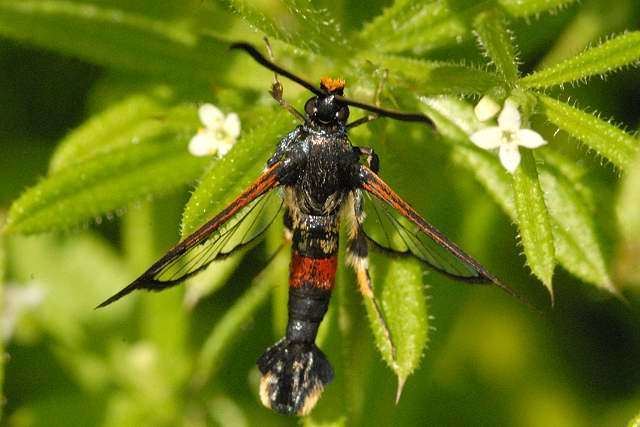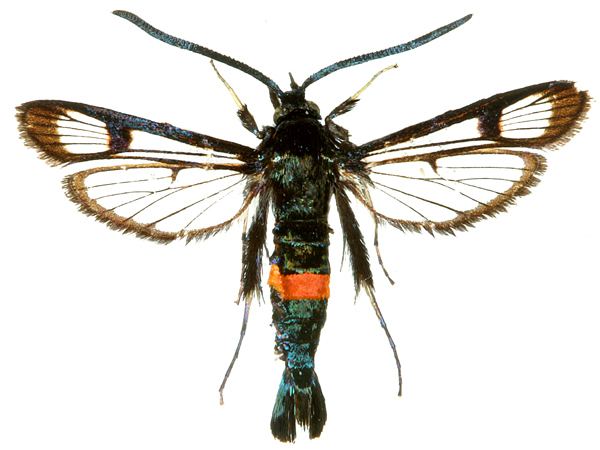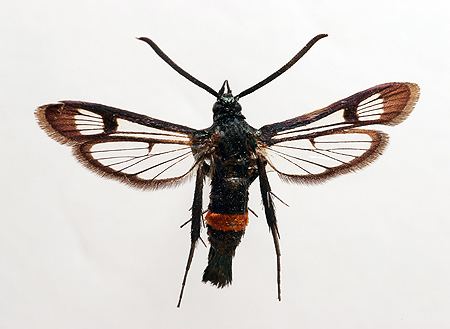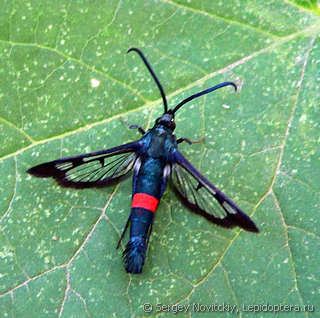Scientific name Synanthedon myopaeformis | Genus Synanthedon Rank Species | |
 | ||
Similar Synanthedon, Synanthedon tipuliformis, Synanthedon culiciformis, Synanthedon formicaeformis, Sesiidae | ||
Synanthedon myopaeformis hatching
Synanthedon myopaeformis is a moth of the family Sesiidae. In Europe it is known as the red-belted clearwing and in North America as the apple clearwing moth. The larvae create galleries under the bark of fruit trees, especially old ones with damaged trunks. This moth is native to Europe, the Near East and North Africa but has been introduced into North America, being first detected in Canada in 2005.
Contents

Subspecies

Description

Synanthedon myopaeformis has a glossy, bluish-black body with a broad transverse orangish-red band on the abdomen. The wings are transparent, glossy and veined with black lines. The fore-wings are narrow and are longer than the hind-wings. The wingspan is 20 to 25 mm (0.8 to 1.0 in).
Habitat

Synanthedon myopaeformis is found in gardens, orchards, woodlands and hedgerows. The larvae feed under the bark of apple trees, crab apples, pears, quinces, plums, cherries, apricots, hawthorn and mountain ash, favouring old cankerous trees.
Life cycle
Adult moths are on the wing in summer and feed on nectar. The eggs are laid singly in wounds and crevices in the bark on the trunk and branches of the host tree. The chosen site is often a burr knot, an irregular rounded growth sometimes found on a tree trunk. The developing larvae feed on sap and create shallow galleries up to 25 mm (1 in) long between the bark and the cambium layer. The following spring, the larvae are ready to pupate, but first they clear the frass out of the tunnel and work their way to near the exit. Before the adult moth emerges, the pupa wriggles so that it projects from the entrance hole so that when the moth breaks out of the pupal case, it is free to fly away. The empty pupal case is left sticking out of the exit hole, and counting these can enable an assessment to be made as to the level of infestation of the host tree.
Pest status
In Europe and the Middle East, Synanthedon myopaeformis has been regarded as a minor pest of fruit trees, but changes in orchard technology since the 1960s have led to it becoming a more serious pest. The larvae weaken the host tree, reduce the crop yield and make the tree more susceptible to attack by fungal diseases. Some control is offered by the wasp Liotryphon crassiseta, the larvae of which are parasitoids of the clearwing moth larvae.
In Canada it has been found that both male and female moths are attracted to the flowers of showy milkweed (Asclepias speciosa) and that it is the phenylacetaldehyde produced by the flowers that attracts them. It has been shown that this substance can be used in monitoring populations of the moth or in mass-trapping them.
